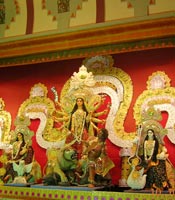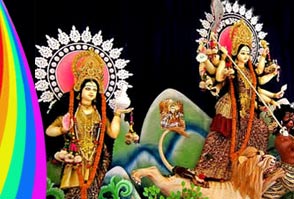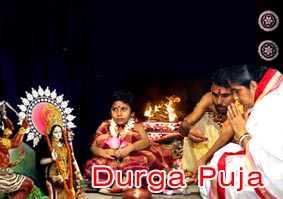With the coming up of the concept of joining clubs, the Durga puja festival celebration has become cosmopolitan in nature. In the contemporary times, Durga puja festivity is like a grand extravaganza. Many days before the arrival of this festivity, people are full of excitement and enthusiasm. As a part of Durga pooja celebrations, beautiful pandals are erected and embellished with flowers. Conchshells and drums have a major role to play in setting the mood for festivity celebration.
 At every nook and corner, you'll find one pandal. Due to the migration
of Bengalis to other parts of the country, Durga puja is now celebrated
in rest parts of the country also. For the craftsmen and artisans, Durga
puja is the time for earning good business. The first four days of Durga
puja are very hectic and witness lot of activities like different kinds
of competitions are held to energize the people. The artists get a
platform to show their talent to the people and make a name for
themselves.
At every nook and corner, you'll find one pandal. Due to the migration
of Bengalis to other parts of the country, Durga puja is now celebrated
in rest parts of the country also. For the craftsmen and artisans, Durga
puja is the time for earning good business. The first four days of Durga
puja are very hectic and witness lot of activities like different kinds
of competitions are held to energize the people. The artists get a
platform to show their talent to the people and make a name for
themselves. The main celebration takes place from the sixth day, i.e. more commonly known as maha shashthi. On this day, the priest displays the deity while performing the puja. Women usually fast on this day praying for the wellbeing of their families. They break their fast in the evening time with fruits and luchis (different kind of bread made from flour). A visit to the local pandal is like a must.
On the seventh day, i.e. maha saptami, people wake up early and on an empty stomach, they offer prayers to the deity. After the prayers are over, Prasad is offered to the deity. During the lunch time, special meal is served to all those, who congregate in the pandals. If you visit the pandals during the evenings, the view is very pleasing, as people with glowing faces are dressed in colorful clothes. The dazzling clothes and ornaments, spectacular lighting, beating of drums, humming of birds and chitchatting of people will set the mood for partying.
The eighth day, which is known as maha ashtami, is one of the most significant days of the Durga puja festivity. While chanting the Shlokas, the priest performs a special puja known as the sandhi puja. On this day, the reflection of the deity is seen in a bowl of water. This gives a feeling of the movement of deity. The puja is popularly known as pranpratishtha (means breathing life into the idol). By the evening, merry making is on its peak.
Pandal hopping is the favorite pastime activity during the occasion of Durga pooja. On the ninth day that is known as maha navmi, meat is served in most of the pandals as a part of Bhog. Since, it is the penultimate day of the Durga puja festival celebration, people start realizing that the festivity is about to get over. This is how the Durga puja celebration takes place in India.







